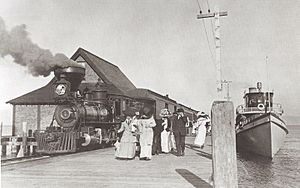SS Tahoe facts for kids

Tahoe circa 1906
|
|
| History | |
|---|---|
| Owner | Duane Leroy Bliss |
| Builder | Union Iron Works |
| Yard number | 42 |
| Launched | 24 June 1896 |
| Fate | Scuttled 1940 |
| General characteristics | |
| Type | Steamship |
| Displacement | 154 tons |
| Length | 169 ft 9 in (51.74 m) |
| Beam | 17 ft 10 in (5.44 m) |
| Draft | 6 ft (1.8 m) |
| Depth | 9 ft 10+1⁄2 in (3.010 m) |
| Installed power | 2 × triple expansion steam engines 1,200 hp (890 kW) total |
| Propulsion | Twin 4 ft 10 in (1.47 m) screws |
| Speed | 18+1⁄2 knots (34.3 km/h; 21.3 mph) |
| Capacity | 200 passengers |
|
SS Tahoe
|
|
| Location | Lake Tahoe |
| Nearest city | Glenbrook, Nevada |
| NRHP reference No. | 04000026 |
| Added to NRHP | February 11, 2004 |
SS Tahoe was a steamship that operated on Lake Tahoe at the end of the 19th century and the first half of the 20th. Scuttled in 1940, the wreck presently lies in 400 feet (120 m) of water off Glenbrook, Nevada. The wreck was first visited in 2002 by a team from New Millennium Dive Expeditions (NMDE) in a record-setting high-altitude dive for Lake Tahoe. As a result of the work that NMDE did on the Tahoe site from 1999 up to their dives in 2002, Tahoe became the first maritime site in Nevada to be listed in the National Register of Historic Places.
Service history
By the end of the 19th century, Lake Tahoe had become known as a vacation resort, with a handful of hotels and communities scattered around its shores, serviced by a number of steamers crossing the lake. Lumber magnate Duane Leroy Bliss ordered the vessel from San Francisco's Union Iron Works in 1894. It was shipped by rail in pieces to Carson City, then by wagon to Glenbrook, reassembled, and launched with much acclaim on June 24, 1896.
At 169 feet (52 m), Tahoe was the largest of the lake steamers; she was propelled by two wood-fired engines developing a total of 1,200 hp (890 kW), each driving a three-bladed propeller. Her 200 passengers enjoyed a well-appointed interior, with leather upholstery, carpeting, and marble fixtures in the lavatories. Modern technologies included electric lights and bells, hot and cold running water and steam heating.
From 1901, Tahoe operated from a railroad pier in Tahoe City during the summer, leaving in the morning, making a daily circuit of the shoreline communities, and returning in the late afternoon. In addition to the passengers, she carried freight and mail.
The completion of a road suitable for cars all around the lake in 1934-35, followed by the loss of the mail contract in 1934 to Marian B, made Tahoe uneconomical to operate, and she lay unused for several years. In 1940, Bliss's son William Seth Bliss repurchased the vessel from the operating company; his intent was to scuttle her in shallow water off Glenbrook as a memorial to a bygone era, visible to glass-bottomed boats. Tahoe was scuttled on August 29, 1940, but the underwater slope was unexpectedly steep at the chosen location, and the ship slid down out of sight, ending up with the bow at 360 feet (110 m) and the stern at 490 feet (150 m).
Wreck discovery
In 2002, the Reno-based non-profit organization New Millennium Dive Expeditions set a record for high altitude scuba diving when they reached the wreck of Tahoe. The information they gathered on the wreck was a crucial part of the documentation enabling Tahoe to be listed on the National Register. The work of the NMDE team continued in 2009 where in August and September they visited the wreck again successfully in preparation for three visits in the summer of 2010.
In July 2016 the vessel was filmed by an underwater drone or remote vehicle as part of a project to develop such devices cheaply.

